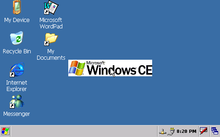Windows IoT
Windows Embedded is a family of operating systems from Microsoft designed for use in embedded systems. Microsoft makes available four different categories of operating systems for embedded devices targeting a wide market, ranging from small-footprint, real-time devices to Point of Sale devices like kiosks. Windows Embedded operating systems are available to OEM system builders only, who make it available to end users pre-loaded with the hardware.
The Windows Embedded family
Windows Embedded Compact

Windows Embedded Compact (previously known as Windows Embedded CE or Windows CE)[1] is the version of Windows Embedded for very small computers and embedded systems, including consumer electronics devices like Set-top boxes and gaming consoles. Windows Embedded Compact is a modular real-time operating system with a specialized kernel that can run in under 1 MB of memory. It comes with the Platform Builder tool that can be used to add modules to the installation image to create a custom installation, depending on the device used. Windows Embedded Compact is available for ARM, MIPS, SuperH and x86 processor architectures.[2]
Microsoft also makes available a specialized version of Windows Embedded Compact, known as Windows Mobile, for use in mobile phones. It is a customized image of Windows Embedded Compact along with specialized modules for use in Mobile phones. Windows Mobile is available in four variants: Windows Mobile Classic (for Pocket PC), Windows Mobile Standard (for SmartPhones) and Windows Mobile Professional (for PDA/Pocket PC Phone Edition) and Windows Mobile for Automotive (for communication/entertainment/information systems used in automobiles). Modified versions of Windows Mobile were also used for Portable Media Centers.
Windows Embedded Standard
Windows Embedded Standard (2009) is the updated version of Windows XP Embedded, the fully componentized version of Windows XP Professional and the successor to Windows NT 4.0 Embedded. It provides the full Win32 API and is available for x86 processors.[2] Windows Embedded Standard 2009 is derived from Windows XP Embedded since Microsoft at the time of its development did not have a componentized version of Windows Vista. [3] Windows Embedded Standard 2009 includes Silverlight, .NET Framework 3.5, Internet Explorer 7, Windows Media Player 11, RDP 6.1, Network Access Protection, Microsoft Baseline Security Analyzer and support for being managed by Windows Server Update Services and System Center Configuration Manager. [4]
Microsoft has announced that the next version, Windows Embedded Standard 2011, will be based on Windows 7 which was previously codenamed Windows Embedded ‘Quebec’.[5] Windows Embedded Standard 2011 is expected to include Windows Vista and Windows 7 features [6] such as Aero, SuperFetch, ReadyBoost, BitLocker Drive Encryption, Windows Firewall, Windows Defender, Address space layout randomization, Windows Presentation Foundation, Silverlight 2 among several other packages. It will be available in x86 and x64 versions and targeted for release in 2010. Reportedly, it will have a larger footprint (~300 MB) compared to 40 MB of XPe and will also require product activation. [6]
Two Community Technology Preview (CTP) releases of Windows Embedded Standard 2011 have been released.[7] Windows Embedded Standard 7 was released on April 27, 2010.[8]
Windows Embedded Enterprise
Windows Embedded Enterprise brand of Windows Embedded Operating Systems consist of Windows XP for Embedded Systems and Windows Vista for Embedded Systems, which are the same versions of the OSs as are available in retail but are licensed exclusively for use in embedded devices.[1] They are available for both x86 as well as x86-64 (x64) processors.[2]
Windows Embedded POSReady
Windows Embedded POSReady is the brand of Windows Embedded Operating Systems for Point of sale systems, including sales kiosks and automatic vending machines. Currently, this brand is limited to the Windows Embedded for Point of Service Operating System, which is based on Windows XP Embedded.[1]
Windows Embedded NAVReady
Windows Embedded Server
History
Win3.x had an embedded version found typically on POS terminals. The NT series developed an embedded product called "XPembedded". The Windows CE series includes Phone Edition and Mobile Edition. Current Windows CE base is version 6.0 R3 which runs on ARM, X86, SH, and derivatives of those architectures. It is a Real-time operating system. A .Net framework, UI framework, and various open source drivers and services are also included.
References
- ^ a b c "Microsoft Charts Its Road Map for Windows Embedded Business". Microsoft PressPass. Retrieved 2008-04-17.
- ^ a b c "Which Windows Embedded Product is Right for Me?". Retrieved 2008-04-17.
- ^ Microsoft Charts Its Road Map for Windows Embedded Business
- ^ Microsoft Press Release on Windows Embedded Standard 2009
- ^ Microsoft Announces the Next Version of Windows Embedded Standard to Be Built on Windows 7
- ^ a b Windows Embedded ‘Quebec’ due in 2010
- ^ Microsoft Delivers Windows 7-Based Windows Embedded Standard 2011 Community Technology Preview
- ^ http://www.microsoft.com/windowsembedded/en-us/about/pressroom/pressreleases/wes7_release.mspx Microsoft Delivers Windows 7 Technologies to Device Manufacturers With Release of Windows Embedded Standard 7
